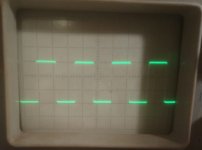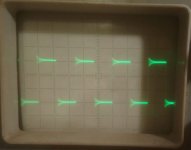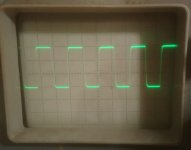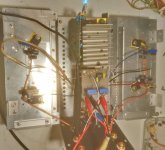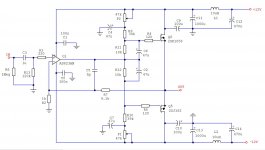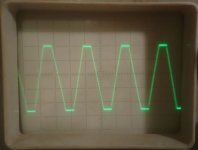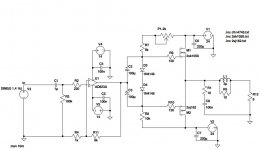Couple of months ago I got two nice SMPSs (12V/6A) originating from discarded computer network equipment and since they are nice, clean and quiet (less than 1mV of 55kHz noise after output filter, at full load) I thought I could use them as a power supply for a small class A power amp (I never used SMPS in a power amp before).
Just to test it I chose the composite topology - OpAmp at input and source follower with Lateral MOSFETs at output. AD823 was my choice because it swings rail to rail. Also it has JFET input (low offset, high Zin) and later I discovered that it sounds really nice in this combination.
To extend the voltage swing of the output stage I bootstrapped the MOSFETs' Gates with C2, C6 so the amp clips at 23Vpp with 24.4V power voltage (the rails are actually 12,2V) which translates into 8W @ 8R i.e. 16W @ 4R.
Output MOSFETs are biased through voltage dividers (P1+R10)/R12 and (P2+R9)/R11.
Biasing starts with max. value of pots (lowest bias). Pots are turned slowly and alternatively (like described in F5 manual) until we reach (depending on your heatsinks and speakers) Id of about 0.5 - 0.7A and DC offset at the output of 0mV (put 0R1 serially in one of the power rails and measure 50-70mV accross it. Remove it after biasing). We use Laterals without source resistors so we can exploit their square law transfer characteristic and the exact bias current value is not that important but you can play with it.
DC offset is very stable, thanks to OpAmp's feedback loop which includes MOSFETs (meaning very low Zout i.e. high damping factor too). The pic shows MOSFETs and voltage dividers as point to point build on the heatsink and the chip is on the perfboard by the PSU so I adjusted the bias and the DC offset before I powered the chip and it stayed stable after inclusion into feedback loop. C5 (SMD) is soldered directly between the chip socket's pins. All electrolytic caps are 16V Japan made NIC (NRSG series - very low impedance): NRSG Series Page
The amp is very stable and fast and sounds much better than I expected. Most of all, it's an easy build. Have fun with it...
Pics show:
- Square wave 15V_pp 20 kHz @ 5R load (5V/div, 20uS/div)
- Square wave 15V_pp 20 kHz with 100nF pure capacitive load (5V/div, 20uS/div)
- Square wave 15V_pp 90 kHz @ 5R load (5V/div, 5uS/div)
- Prototype build (when put together the amp measures 22cm x 22cm x 10cm - heatsinks are 22cm x 10cm x 4 cm and they go to about 20 degrees C. above the ambient temp.)
- Schematic diagram (every channel has its own power rails filter)
- Hard clipping of 20 kHz triangle wave (5V/div, 20uS/div)
P.S. Dobrivoje, thank you for the heatsinks !
Just to test it I chose the composite topology - OpAmp at input and source follower with Lateral MOSFETs at output. AD823 was my choice because it swings rail to rail. Also it has JFET input (low offset, high Zin) and later I discovered that it sounds really nice in this combination.
To extend the voltage swing of the output stage I bootstrapped the MOSFETs' Gates with C2, C6 so the amp clips at 23Vpp with 24.4V power voltage (the rails are actually 12,2V) which translates into 8W @ 8R i.e. 16W @ 4R.
Output MOSFETs are biased through voltage dividers (P1+R10)/R12 and (P2+R9)/R11.
Biasing starts with max. value of pots (lowest bias). Pots are turned slowly and alternatively (like described in F5 manual) until we reach (depending on your heatsinks and speakers) Id of about 0.5 - 0.7A and DC offset at the output of 0mV (put 0R1 serially in one of the power rails and measure 50-70mV accross it. Remove it after biasing). We use Laterals without source resistors so we can exploit their square law transfer characteristic and the exact bias current value is not that important but you can play with it.
DC offset is very stable, thanks to OpAmp's feedback loop which includes MOSFETs (meaning very low Zout i.e. high damping factor too). The pic shows MOSFETs and voltage dividers as point to point build on the heatsink and the chip is on the perfboard by the PSU so I adjusted the bias and the DC offset before I powered the chip and it stayed stable after inclusion into feedback loop. C5 (SMD) is soldered directly between the chip socket's pins. All electrolytic caps are 16V Japan made NIC (NRSG series - very low impedance): NRSG Series Page
The amp is very stable and fast and sounds much better than I expected. Most of all, it's an easy build. Have fun with it...
Pics show:
- Square wave 15V_pp 20 kHz @ 5R load (5V/div, 20uS/div)
- Square wave 15V_pp 20 kHz with 100nF pure capacitive load (5V/div, 20uS/div)
- Square wave 15V_pp 90 kHz @ 5R load (5V/div, 5uS/div)
- Prototype build (when put together the amp measures 22cm x 22cm x 10cm - heatsinks are 22cm x 10cm x 4 cm and they go to about 20 degrees C. above the ambient temp.)
- Schematic diagram (every channel has its own power rails filter)
- Hard clipping of 20 kHz triangle wave (5V/div, 20uS/div)
P.S. Dobrivoje, thank you for the heatsinks !

Attachments
Last edited:
Nice! A super-charged Class-A FET OPS with what you found in your drawers!
Guess it measures as well as it sounds.
Should have a supercharged PSRR as well and thanks to the CLC-filter compatible to most SMPS.
Would be fun to take two laptop power supplies @~19V and try it with a OPA604 or so at higher output voltage (whilst watching the oscilloscope).
Guess it measures as well as it sounds.
Should have a supercharged PSRR as well and thanks to the CLC-filter compatible to most SMPS.
Would be fun to take two laptop power supplies @~19V and try it with a OPA604 or so at higher output voltage (whilst watching the oscilloscope).
Really nice. Thanks juma.
Is there any branding on the SMPSs (or specs)? If I had a crystal ball, I think it would show more SMPSs being used in our DIY future.
Is there any branding on the SMPSs (or specs)? If I had a crystal ball, I think it would show more SMPSs being used in our DIY future.
Member 6L6 and I are experimenting with some of the 25 W/ch class A amps designed by First Watt (Nelson Pass) and available thru the diyAudio Store. Run from switch mode power supplies whose output is post filtered by four pole inductor/capacitor filters, these amps appear to sound as good or, usually, better with the SMPS than with the standard First Watt conventional linear supply with 300VA toroidal power transformer.
Hi Joensd,
I didn't extensively measure the performance but I guess that it's close to performance of the OpAmp, augmented by the power capability of the output stage. It's easy to achieve more power but I just wanted to see how it fares with available PSU.
Tibi,
There are numerous ways to arrange the output stage. The Gates can be made to swing even higher but the Sources are still limited by PSU voltage. Common Source topology comes to mind too...
drbjf1,
looking at the power modules I see no brand markings so I gues it's some OEM stuff, maybe somewhat better than standard offerings (the network equipment they come from was not cheap). SMPSs just have to be reliable and quiet (they are small and light already) and they will find their way into wider use in DIY builds.
Hi Mark,
I'm glad to hear that because I'm sure that you'll test it more thoroughly than I did. I was satisfied to see those SMPSs being quiet and cool. Current delivery and voltage stiffness are non-issue anyway.
I didn't extensively measure the performance but I guess that it's close to performance of the OpAmp, augmented by the power capability of the output stage. It's easy to achieve more power but I just wanted to see how it fares with available PSU.
Tibi,
There are numerous ways to arrange the output stage. The Gates can be made to swing even higher but the Sources are still limited by PSU voltage. Common Source topology comes to mind too...
drbjf1,
looking at the power modules I see no brand markings so I gues it's some OEM stuff, maybe somewhat better than standard offerings (the network equipment they come from was not cheap). SMPSs just have to be reliable and quiet (they are small and light already) and they will find their way into wider use in DIY builds.
Hi Mark,
I'm glad to hear that because I'm sure that you'll test it more thoroughly than I did. I was satisfied to see those SMPSs being quiet and cool. Current delivery and voltage stiffness are non-issue anyway.

Juma, this looks very interesting. i might have a go at laying out a PCB for it (at some point) 🙂
As for PSUs I guess the MeanWell IRM modules would be an option as well? Small, cheap and both 12V and 15V versions available 🙂
As for PSUs I guess the MeanWell IRM modules would be an option as well? Small, cheap and both 12V and 15V versions available 🙂
I had an eye on these too as 2pcs. are still comparable to a Connex or similar (in price) and these can be switched in series.I guess the MeanWell IRM modules would be an option as well?
If you wanna go cheap: There is an abundance of laptop PSUs on iihbay and the likes. Also look out for transformers for halogen lights (~12VAC) with plenty of [VA] as they are slowly but surely getting out of date.
.
Old printer supplies (HP for example) can be very nice/reliable/quiet and have up to 25V/2A but these are big and heavy too.
Hi Juma
not sure if it's of interest but I put together a latfet pp using the 823 with meanwell 24v smps. The final boxed version used a different ps but the smps version was outstanding. This is a very naive circuit but it produced a sound quality way beyond my expectations. I also used the same smps to power a minimal version of the mofo which also had an 823 front end with a gain of 3. This also surprised me with the sound quality.
The full amp discussions are here:
more lateral fets - audio-talk
and here:
even more lateral fets - audio-talk
not sure if it's of interest but I put together a latfet pp using the 823 with meanwell 24v smps. The final boxed version used a different ps but the smps version was outstanding. This is a very naive circuit but it produced a sound quality way beyond my expectations. I also used the same smps to power a minimal version of the mofo which also had an 823 front end with a gain of 3. This also surprised me with the sound quality.
The full amp discussions are here:
more lateral fets - audio-talk
and here:
even more lateral fets - audio-talk
Attachments
I have no experience with MeanWell but if they are reliable and quiet, they'll do alright for sure.... I guess the MeanWell IRM modules would be an option as well? ...
Naive can still be surprising 😀 I see you didn't include the MOSFETs in the feedback loop and a lot of voltage in the output stage goes wasted so common source topology or bootstraping might be beneficial. Anyway, if you are satisfied......This is a very naive circuit but it produced a sound quality way beyond my expectations....

Thanks for the links
Last edited:
Nice as always Juma, minimalistic low power amps are more interesting to me as I grow older. Cheers.
It is kind of a little off-topic, sorry, Juma.
Over time, I snatched 3 x 24V 400W Vicor flatpc's from Ebay at around USD60 - USD70 ea.
The Vicors were used and well built. 2 of them together will drive typical Papa amps and a couple Juma class A variances very well. I will keep my eyes on Mark's and Jim's 4-pole LC filter posts. My plan is to place the flatpac in it's own ps chassis and the LC filter inside the amp's chassis.
I believe there is at least one member using the Vicor for the Papa amp and had very good result.
Over time, I snatched 3 x 24V 400W Vicor flatpc's from Ebay at around USD60 - USD70 ea.
The Vicors were used and well built. 2 of them together will drive typical Papa amps and a couple Juma class A variances very well. I will keep my eyes on Mark's and Jim's 4-pole LC filter posts. My plan is to place the flatpac in it's own ps chassis and the LC filter inside the amp's chassis.
I believe there is at least one member using the Vicor for the Papa amp and had very good result.
I have 2 10A versions and they are brilliant as is. In the datasheet for that "family" of converters (Vi-200) they have an optional LC-filter for even better ripple at full load. Good job on buying them so cheap!Over time, I snatched 3 x 24V 400W Vicor flatpc's from Ebay at around USD60 - USD70 ea.
+1 to the VI-200!!
I only have the half-brick, VI-100 (18-36 IN, 24V OUT). I plan to power the ACP+ preamp/HA with a 30VDC wall brick that I saved from landfill.
Check them out if you're interested
http://www.vicorpower.com/documents/applications_manual/DesignGuideAppsManual_200J00.pdf
I have no measurement equipment, so my praise is nothing more than "they worked and sounded great."
I only have the half-brick, VI-100 (18-36 IN, 24V OUT). I plan to power the ACP+ preamp/HA with a 30VDC wall brick that I saved from landfill.
Check them out if you're interested
http://www.vicorpower.com/documents/applications_manual/DesignGuideAppsManual_200J00.pdf
I have no measurement equipment, so my praise is nothing more than "they worked and sounded great."
Not at all - SMPS as a power amp's PSU is a valid topic here.It is kind of a little off-topic....
- Home
- Amplifiers
- Pass Labs
- SMPS powered small cl. A amp
